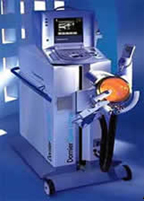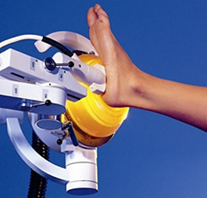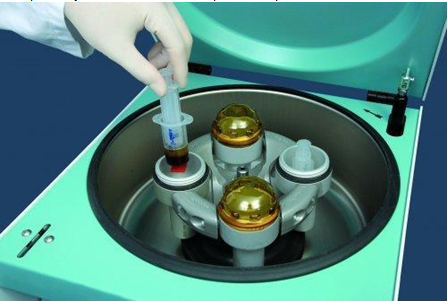Heel Pain Treatment Options
There are a multitude of advanced treatment options for heel pain. Often, these treatments are used if conservative care such as physical therapy, orthotic insoles, shoe modifications, stretching and cortisone injection do not seem to be helping.
In such cases, UFAI's Heel Pain Institute offers the most comprehensive and advanced options for chronic plantar fasciitis pain. The treatment is individualized to the patient's needs with emphasis on rapid recovery and complete resolution of heel pain. A list of treatment options is given below:
 Advanced Tissue Repair Services:
Advanced Tissue Repair Services:
- Shockwave Therapy
- PRP (Platelet Rich Plasma) Injection Therapy
- Stem Cell Therapy
- RelēF Procedure
- Tenex Procedure
- Topaz Procedure
Fascia Release Techniques:
Advanced Tissue Repair Services:
Shockwave Therapy
 Extracorporeal shockwave therapy is one of the first treatments for chronic heel pain that fails to respond to conservative care. Both low- and high-strength treatments may be performed, but we have found the high-strength treatment causes more pain, requires the use of anesthesia and may not get rid of the heel pain with a single treatment. We therefore prefer the low intensity treatment, performed 3-4 times. The treatment is performed inoffice, with no need for anesthesia. A low energy ultrasound probe is used to break up the scar tissue in the heel region and increase the blood supply to the damaged tissue. This in turn results in soft tissue healing. The patient is allowed to walk on the foot in a regular shoe after each procedure and there is no downtime after the procedure. Often, the procedure will take 3-4 tries to get full healing and improvement of the plantar fascia pain.
Extracorporeal shockwave therapy is one of the first treatments for chronic heel pain that fails to respond to conservative care. Both low- and high-strength treatments may be performed, but we have found the high-strength treatment causes more pain, requires the use of anesthesia and may not get rid of the heel pain with a single treatment. We therefore prefer the low intensity treatment, performed 3-4 times. The treatment is performed inoffice, with no need for anesthesia. A low energy ultrasound probe is used to break up the scar tissue in the heel region and increase the blood supply to the damaged tissue. This in turn results in soft tissue healing. The patient is allowed to walk on the foot in a regular shoe after each procedure and there is no downtime after the procedure. Often, the procedure will take 3-4 tries to get full healing and improvement of the plantar fascia pain.
PRP (Platelet Rich Plasma) Injection Therapy
 PRP or platelet rich plasma therapy is a new and advanced technique for the treatment of chronic plantar fasciitis and pain. With chronic cases of plantar fasciitis that have not responded to conservative options, there may be a lack of blood supply necessary for healing and associated chronic scar tissue in the damaged region. In other words, the body just finds the region of damage to be the new normal and does not respond to help heal the damaged tissue. The goal of platelet rich plasma treatment is to increase blood supply and growth factors necessary to the region of scarring and damage in the plantar fascia to help with healing.
PRP or platelet rich plasma therapy is a new and advanced technique for the treatment of chronic plantar fasciitis and pain. With chronic cases of plantar fasciitis that have not responded to conservative options, there may be a lack of blood supply necessary for healing and associated chronic scar tissue in the damaged region. In other words, the body just finds the region of damage to be the new normal and does not respond to help heal the damaged tissue. The goal of platelet rich plasma treatment is to increase blood supply and growth factors necessary to the region of scarring and damage in the plantar fascia to help with healing.
Treatment is performed in the office setting under ultrasound guidance. The ultrasound allows us to place the material in the ideal region of chronic scar tissue. A blood draw from the arm, much like lab work blood draws, is used to get the blood necessary. The blood is spun in a special machine to concentrate the PRP cells and then the concentrated cells are injected back into the damaged tissue. The patient is protected after the injection to prevent pain and swelling and to control stress on the region during the healing process.
Watch PRP Therapy at Work:
Stem Cell Therapy
The injection of mesenchymal stem cells has advanced the field of medicine more than any single treatment in the past decade. From correcting vision to improving liver function, stem cells are the building blocks of all tissue in the body. A stem cell is the cell associated with tissue building and tissue repair. Mesenchymal stem cells can be found in both body fat and bone marrow. Our preferred technique is to harvest the stem cells from the bone marrow with a small needle under local anesthesia. The bone marrow is then spun in a special machine that concentrates the stem cells, which are then injected back into the plantar fascia region. This helps increase the healing cells in the region and also dramatically decreases the swelling in the region. Complete resolution of pain may take 4-6 weeks but most patients respond to the treatment within the first 2 weeks.

Relef Procedure
RelēF (pronounced relief) is not a spelling error. It is the trade name for a radio frequency procedure that helps heal damaged soft tissue, such as the plantar fascia in cases of plantar fasciitis. The radio frequency technology helps break up the scar tissue in the plantar fascia, while the addition of heat helps increase blood supply to the damaged region to increase healing. The skin is cooled by a patented liquid mist technology while the heat is transferred to the deeper tissue by the probe. The procedure is performed in an office setting without need for anesthesia.The foot is protected in a boot for about one week after the procedure. It is often necessary to perform 2 procedures for the complete resolution of plantar fasciitis.
Watch the Relef Procedure Performed in Los Angeles
Tenex Procedure
The Tenex procedure is a minimally invasive procedure to remove the scar tissue and increase blood supply in the plantar fascia. In cases of severe plantar fasciitis, there is chronic scar tissue in the heel region. The Tenex procedure uses an ultrasound wave and a patented suction device to break up and pull out the scar tissue in the plantar fascia. The procedure is performed in the office under local anesthesia or in the surgery center with mild sedation, if the patient prefers. A small needle hole is made on the side of the heel and the probe is introduced into the scar tissue area under ultrasound guidance for precise placement. The scar tissue is broken up and suctioned out of the heel area. The foot is placed in a boot and protected for 1-2 weeks. Usually the heel pain takes about 4 weeks to resolve.
Watch the Tenex Procedure Performed in Los Angeles
Topaz Procedure
University Foot and Ankle Institute is proud to have performed the original research that led to the development of the Topaz procedure in plantar fasciitis cases. Originally, the procedure required an incision.But after our research, we determined that the procedure could be just as effective through a series of small needle holes instead of a large incision. This increases the healing time and decreases the risk of scar formation. The procedure is done in the office under local anesthesia or in the surgery center with mild sedation. A series of needle holes are made into the plantar fascia region of pain and the Topaz probe is inserted and used to break up the scar tissue through a large burst of heat and energy. The micro fascia releases break up the scar tissue and release the fascia in a microscopic level that allows for healing and less pull of the fascia on the heel. This is what we refer to as a micro plantar fascia release. The fascia still functions but is less tight. Recovery is about 4 weeks and a boot is usually used for 3 weeks after the procedure. Physical therapy may be necessary to decrease pain and help with healing.
Fascia Release Techniques:
Plantar Fascia Release Techniques:
Only about 5% of the more than 3000 cases of plantar fasciitis we see each year require release of the plantar fascia. We pride ourselves on avoiding a release procedure untilour other treatment options have been exhausted. Even in cases of plantar fascia release, we use different techniques depending on the region of pain and the amount of pain associated with the region.
Endoscopic Plantar Fascia Release
Endoscopy refers to minimally invasive soft tissue procedures through the use of a camera. In the case of a plantar fascia release, we use a 1-centimeter incision and a camera with a special blade to release the tight band of plantar fascia in the arch side of the heel. The procedure is done in the surgery center under sedation and the patient wears a boot for 1-2 weeks. Physical therapy is usually performed to prevent scar tissue formation after the procedure. This minimally invasive technique has been our standard go-to technique if all else fails.
In-step Plantar Fascia Release
The in-step plantar fascia release is used in cases of a severely tight plantar fascia that has pain associated with the heel and possibly the arch region. In some cases, strands of the plantar fascia may have some adherence to the arch region and a heel release may not allow for a complete resolution of pain. An in-step arch plantar fascia release allows release of the fascia in the tightest region and the incision is made in a non-weight bearing region of the foot. The procedure is done in a surgical center under sedation. An incision is placed in the arch region and the fascia is released in its arch side only. The outer side of the fascia is left intact to support the outside portion of the foot while the arch portion, which is normally tight, is released. The patient is allowed to put weight on the foot right after surgery in a boot and is kept in the boot for about 3-4 weeks. Physical therapy is started at 3-4 weeks to break up scar tissue and help with return to full activity, which is expected to take 6-8 weeks in total from the time of surgery.
UFAI's Heel Pain Institute of Southern California
As you can see, there are a multitude of options for the treatment of plantar fasciitis. The Heel Pain Institute at University Foot and Ankle Institute is one of the only locations in the world to be versed in almost all forms of researched and documented plantar fascia treatments. By knowing the different options in detail, we understand that not all procedures are best for all patients. We can custom design a protocol for your heel pain treatment in order to accommodate your lifestyle, recovery time constraints and activity levels. Our goal is cost-effective, rapid recovery from heel pain in a family friendly atmosphere. Contact us or visit one of our Southern California locations below to take your first step towards true heel pain relief.

